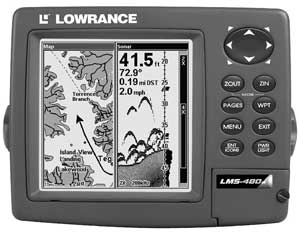
I recently saw an exchange between fishermen on the Internet. One wanted to know if 500 watts was enough power for someone who fishes water no deeper than 30 feet. Another told him that having more pixels was more important than having a lot of power in shallow water, and the more pixels the better.Actually, almost any of today’s units have enough power and pixels for fishing in 30 feet of water, and here’s why.
LCD screens are grids of pixels aligned in vertical columns and horizontal rows like the squares on a checkerboard. The vertical columns do the depth measurement and separate suspended objects like fish from each other and the bottom. The more pixels in each column, the less linear depth each pixel represents and the closer together objects can be and still be shown as separate marks.
The horizontal rows are more a measurement of time, the more pixels in each row the longer things stay on the screen before scrolling off. A large number of horizontal pixels also gives you better split screen displays. Extra-wide screens can show two side-by-side windows that look as good and have as long a screen history as most units’ full-screen displays.
I think the vertical columns of pixels are more important because they determine a screen’s ability to separate targets and control how fine bottom contour and structure can be pictured. More is better in this case, up to the point where the unit’s electronics can no longer back up the screen resolution. The pixel counts of most of today’s units outrun their electronics in 30 feet of water.
Units commonly advertise a target separation capability of from 3 to 6 inches. This means, for example, if a unit has 3-inch target separation and scans two suspended fish, one fish must be 3 inches farther from the transducer than the other for the two of them to be shown as separate marks. If they are closer than 3 inches to each other in the vertical water column, they will be merged together into a single, larger mark.
Let’s see how many pixels you need to show a 3-inch target separation.
Screens commonly have at least 240 pixels in each vertical column. If we set a 240-vertical pixel unit to show a 0- to 30-foot depth scale, we can divide the 30 feet of depth by the screen’s 240 pixels to find out how much linear depth each pixel represents. In this case, each pixel represents 0.13 feet, or about one and a half inches.
In order to show 3 inches of empty vertical space between two suspended fish, the screen simply needs to show two blank pixels between the fish marks.
If all you need are pixels that represent 3 inches of depth to show the best target separation that your unit can deliver, then a screen with 120 pixels could theoretically do the job.
It would certainly be a waste of money to step up to a unit with 320, 480 or more vertical pixels if you only fish in 30 feet of water, especially when you consider that using 2X zoom cuts the measurement represented by each pixel in half and 4X zoom reduces pixels to one fourth of their full-screen size.
Of course, most of us fish water deeper than 30 feet, or at least cross deeper water on our way to fish shallow hotspots, and can make use of units with higher vertical pixel counts.
And if we have combination fish finder/GPS units, we can’t have too much vertical and horizontal resolution when it comes to showing map and chart detail.
However, when selecting a stand-alone fish finder, you can use the formula (depth divided by vertical pixel count equals the linear depth represented by each pixel) to determine how many pixels you really need.


